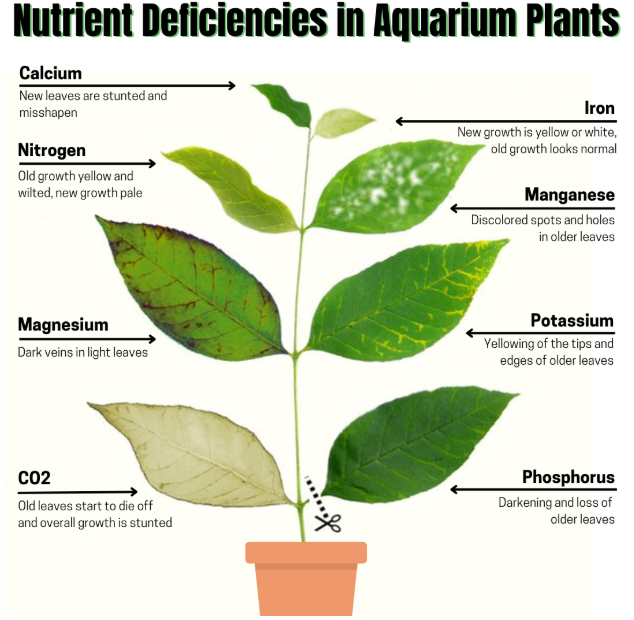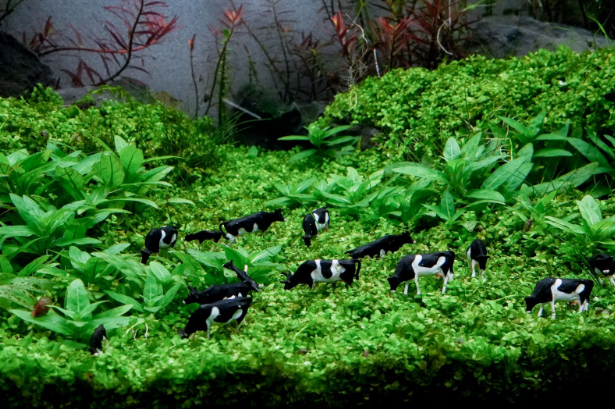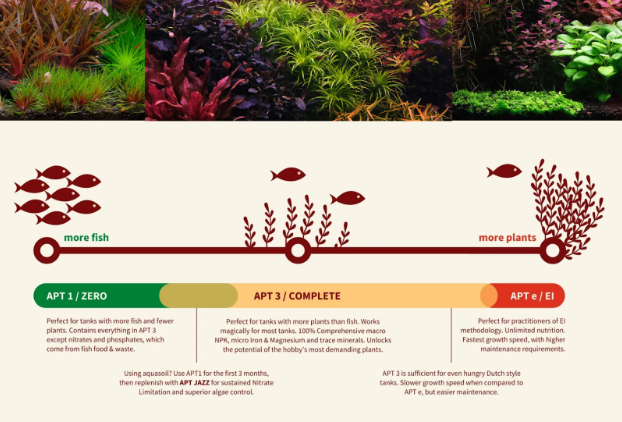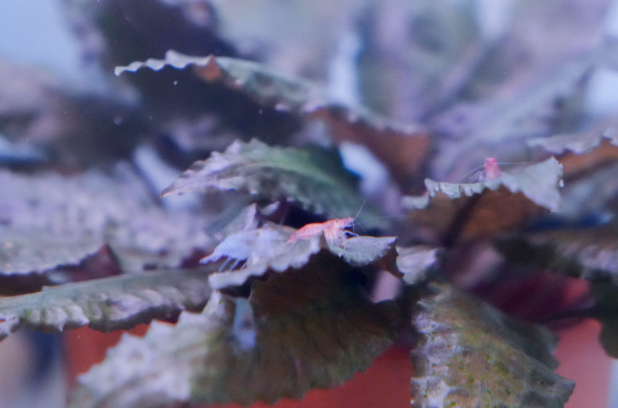Do Aquarium Plants Need Fertilizer? A Guide to Nutrients and Growth
May 16th 2025

May 16th 2025

Creating a successful aquascape goes beyond its beautiful layout. It also requires knowledge of the growth and nutrition of aquatic plants. The careful arrangement of driftwood, rocks, and substrate provides the initial aesthetic building blocks. Still, the perpetual balancing act of light, carbon dioxide, and nutrients supports the overall health of the plants. Fertilization creates the most confusion among all the components, especially among novices.
Do aquatic plants need fertilizer? Does fish waste provide enough nutrients for plants to thrive? In today’s blog, we will answer questions about fertilization and the sustenance of a healthy, balanced aquascape while discussing the effects of fertilization on plant health, water quality, and the tank's stability.
In some cases, aquariums that are overstocked with fish might generate enough waste to provide certain nitrates and phosphates, but potassium and iron are almost always lacking.
Like any organism, aquarium plants require a range of nutrients; when insufficient, they will be deficient, poorly developed, and more susceptible to algae. Imagine living off a diet limited to hot dogs and fries only… that’s what a malnourished diet looks like, and it’s equally harmful to suffering plants.
The health and vitality of aquarium plants depend on the nourishment provided by fertilizer. When combined with adequate livestock and quality aquarium soil, these factors can only support the plants to a certain extent in supplying macronutrients, micronutrients, and even trace elements. As with any situation, considering every angle is crucial, which requires a breakdown of these elements and how plants utilize them.

Proper nutrition and consistent intake of critical nutrients are essential to all life forms. Plants rely heavily on macronutrients for growth, reproduction, and other stored energy functions.
The primary trio of macronutrients for plants consists of nitrogen, phosphorus, and potassium. These nutrients aid in green foliage, root growth, and disease resistance and are vital for maintaining a plant’s life. Understanding macronutrient assimilation is important because healthy environments would not be possible without it.
Identifying these disorders and similar issues can help prevent irreversible damage to the plants. Macronutrients also create a defense system that protects the plant from internal and external vulnerabilities.
Thickened stems, slowed growth, wilting, gray-green or yellow leaves, and dry leaves alongside deteriorating flowers become the new standard over time. Understanding the balance of these macronutrients is essential for all cultivators, gardeners, and pond plant enthusiasts. Such formulations enhance performance rather than decay while improving the natural beauty of an ecosystem.
It’s not only the key macronutrients that influence the health of plants; even the lesser-known players have an essential role to play as well. The health and growth of plants are equally dependent on micronutrients, albeit in much smaller amounts, as well as other nutrients.
Some elements crucial to these processes include ferric, magnesium, and minute amounts of boron, copper, manganese, molybdenum, and zinc. Photosynthesis, enzyme systems, and root development all require these elements. Any one of these elements, although in very tiny amounts, is essential for balance within a plant.
Furthermore, plants often have exact indicators of deficiency in these micronutrients. The subtle symptoms suggest greater issues, ranging from yellowing between veins to twisted leaves and stunted tips.
Insufficient iron may bleach young leaves, while inadequate magnesium affects older ones. The deficiency of one or more trace elements impacts hormonal function and nitrogen metabolism in nearly all plant organs.
These small nutrients facilitate uniform growth, vibrant color, and a well-balanced plant form, necessitating careful attention. Ensuring the full availability of nutrients, even in healthy ecosystems such as backyard ponds and ornamental landscapes, guarantees excellent plant performance.
These nutrients work together to maintain aquatic plants' nutritional health, aesthetic color, and growth habits. Balanced fertilizer dosing prevents any component from becoming a limiting factor in development, allowing the planted aquarium to reach its optimal potential.
Aquatic plants thrive with carbon dioxide (CO₂) as one of their life-supporting essentials. Furthermore, aquarium plants, like terrestrial ones, utilize CO₂ during photosynthesis, transforming light energy into carbohydrates critical for growth.
During photosynthesis, light and CO₂ are essential for producing oxygen alongside glucose. Light is often the spotlight in aquascapes, but CO₂ is equally important. Without a sufficient amount, plants will struggle to convert light into energy, regardless of the nutrient levels in the water or the strength of the light available.
If any of these are disproportionate or absent, growth will fall short.
While growth is easily managed, it is unaccompanied by vibrant coloration or compact structures. More importantly, success with red and carpeting plants will be low.
Several methods are available to increase dissolved CO₂ levels, including pressurized systems.
CO₂ injection is one of the most transformative upgrades to a setup you could make. And it doesn’t just supercharge growth; it also helps plants outcompete algae, improves nutrient uptake, and supports more precise aquascaping.

Carpeting plants like Monte Carlo or Staurogyne repens maintain compact, dense growth with injected CO₂.
Aquarium plants may appear tranquil and effortless, but they require a precise balance of nutrients to grow vigorously behind the scenes. This balance is crucial for the overall health of the tank. And that’s where fertilizers come into play. Like land plants, aquatic species depend on macronutrients and micronutrients for growth.
However, the method of obtaining these depends on the position of the plant within the tank. Every plant, whether floating freely, anchored to the substrate, or affixed to driftwood, benefits from properly administered fertilizer.
Selecting the appropriate fertilizer goes beyond simply grabbing a bottle from the shelf. It considers the types of plants, the layout of the tank, and even the presence of fish. Liquid fertilizers are the top choice for stem plants and mosses since they use leaves as their primary means of nutrient absorption.
Rooted species such as Cryptocoryne and Vallisneria perform better with root tabs, but these only provide the best nutrients to the base. Additionally, every tank’s ecosystem differs from one another. A lightly planted tank with high fish waste levels has vastly different needs than a heavily planted aquascape without CO2 injection.
Knowledge of the workings of each fertiliser and the needs of the aquarium plants helps prevent most problems, such as algae blooms, stunted growth, or discolored leaves. With proper maintenance and dosing in the water column or the substrate, aquatic plants can be kept looking fresh, and the environment can remain healthy and stable.
"Water column liquid fertilizers" or liquid fertilizers refer to products that can be added directly into the tank as solutions. Since the leaves can absorb the nutrients, they are provided in solution form. This technique is effective for stem plants, floating plants, and mosses.
As encapsulated solid or slow-release fertilizers, root tabs are placed close to the feeder's roots within the substrate. These fertilizers provide nutrients to the roots, not the water column.
Every aquarium is different, and this is especially true when providing nutrition for plants. Selecting an appropriate fertilizer requires more than simply purchasing a popular brand; it involves grasping the intricate biology of the tank, its plants, and even the number of fish present.
Each ecosystem has unique nutrient needs, and adopting a universal strategy often yields unsatisfactory outcomes and a surge in algae growth. Instead, tailored approaches adapted to specific conditions promote robust and healthy plant growth.
Let’s first focus on the aquarium, which has sparse plant life and an overabundance of fish. At first glance, the situation appears perfect, with all the fish waste providing an organic source for the plants to thrive.
Unfortunately, fish waste also falls short of supplying critical potassium, iron, and magnesium, in addition to nitrogen and phosphorus. A liquid fertilizer that includes trace amounts of nitrogen and phosphate but compensates for potassium, iron, and magnesium can significantly benefit the setup. Dosing every other day or providing smaller amounts daily fosters strong plant growth without triggering an algae bloom.
The absence of CO2 injection in highly planted tanks presents a new challenge. Growth here tends to be large-scale but slow over a longer period. Their nutrient demands are minimal. A complete blend of liquid fertilizer is helpful in moderation. It must contain some level of nitrogen and phosphorus, but should only be used where fish populations are low or moderate.
Smaller doses, applied routinely, make it easier for the system to avoid being overwhelmed. The intentions remain similar in both circumstances—supporting plant growth while maintaining a balanced ecosystem—in this case, fish and blooming plant life.
The nutrients in aquariums with heavy fish loads and low plant levels are particularly demanding. While fish waste may seem sufficient for plants, it only tells part of the story. Fish waste covers nitrogen and phosphorus to some extent, which can lead to an overabundance of these nutrients.
However, just because nitrogen and phosphorus exist does not mean that everything else the plants are exposed to is in harmony. The aftermath is an unbalanced state with excessive amounts of some nutrients and others barely scraping by.
The bottom line is this: too many fish and not enough plants result in an environment devoid of potassium, iron, and magnesium, some of the key elements that support plant life. These nutrients directly affect photosynthesis, foliage growth, and overall health; hence, a lack of nutrients will impede their functions.
In this scenario, without fertilizers brimming with nitrogen and phosphates, the tank should opt for a liquid formula exclusive to the missing components. Delivering small amounts every other day or splitting doses keeps the water column stable, wasting zero nutrients and being far less turbulent than the bolus style. It’s minimal effort for the keeper to maintain a stable tank.
CO2 not injected into an aquarium with dense flora will create unique conditions. The dense flora is beneficial, but a lack of supplementary carbon stunts growth. While growth does not cease, it becomes more orderly and slower. Excessive passive care can lead to algae problems, cloudy water, and even nutrient lockout in these setups.
An all-in-one fertilizer with essential nutrients in micro dosages is preferable to maintain balance. A comprehensive multi-micronutrient liquid fertilizer will be effective, especially one containing nitrogen, phosphorus, potassium, iron, and other crucial micronutrients. Healthy and slow growth can also be supported if the fish population is low to moderate.
Added nitrogen and phosphorus can be supplied at intervals every day or every other day, allowing them to adjust gradually based on the plants' response. The end goal is to provide what is missing without oversaturating the system. If done correctly, this keeps the aquascape clean and green while ensuring stable and gradual plant development.
Plants like cryptocoryne and echinodorus are considered root feeders and contribute significantly to the design and beauty of aquariums. However, they differ from other species regarding nutrition.
Unlike stem plants or floaters that draw nutrients from the water column, these rooted varieties rely heavily on the substrate. Plants depend significantly on what’s in the substrate. If the substrate loses nutrients, these rooted plants can exhibit stunted growth, develop damaged leaves, or even melt away.
There is a solution: regular application of root tabs. These should be replaced every two to three months or when the tank needs a nutrient boost, as this time frame provides consistent support. Replacing the root tabs at that frequency also ensures the plants avoid capped-off nutrient flow, which allows strong root systems.
The dosage of liquid fertilizer can also be increased to enhance overall tank balance and support any nearby non-root feeders without disturbing the system. Supporting these plants helps maintain a uniform and coordinated aquascape, providing the feeder plants with everything they need while avoiding system disturbances.
Choosing the right fertilizer goes beyond simply selecting liquid over root tabs. It involves planning a strategy that meets your aquarium's needs. Plant types, substrate makeup, lighting strength, and the presence of CO2 all dictate the type and amount of fertilizer needed.
Plants don’t depend on nutrients uniformly, so knowing whether your plants take up nutrients from leaves or roots will help you place resources exactly where they are needed. No one-size-fits-all approach will work; every tank and its ecosystem are unique.
For aquariums with diverse plant species, using a combination of liquid fertilizers and root tabs is often the most effective approach. Tabs provide easier access to bottom feeders like cryptocoryne and echinodorus, while stem and floating plants absorb nutrients from the water column. This method ensures that all anchored plants receive the necessary support regardless of location.
Even with a balanced routine, maintaining equilibrium is key to achieving long-term success. If there is too much of a single element, one may face excessive algae blooms; too little will stall plant growth.
That's why monitoring your plants is just as crucial as providing them with the right nutrients. Plants convey their health status by altering their leaf color, growth rates, and even the speed at which new shoots emerge. Adjusting your care approach based on these signals helps maintain nutritional balance.
In many respects, aquarium fertilization is less about exact measurements and more about an ongoing dialogue with the plants. The more attention you give and the more responsive you are to the plants' signals, the healthier your aquarium will be regarding plant growth, stability, aesthetics, and the ecosystem's overall health.

2Hr Aquarist’s fertilizer line is tailored to the needs of aquascapers, as seen in this product comparison chart.
Fertilizing a planted aquarium initially seems simple—add nutrients and watch your plants grow. However, even with top-quality products, it’s easy to misstep and end up with yellowing leaves, stalled growth, or a tank overrun with algae. The truth is that success lies in the details. Knowing how much to dose, when, and what your tank needs makes the difference between a thriving aquascape and a struggling one.
Even well-intentioned choices, like adding extra nutrients “just in case” or copying someone else’s dosing routine, can throw your system out of balance if it isn’t tailored to your specific setup.
Moreover, many issues in planted tanks, such as algae outbreaks, poor coloration, or growth irregularities, aren’t always due to bad lighting or bad luck. Often, they trace back to subtle mistakes in fertilization that could have been avoided with a more measured approach. From neglecting the nutrient load of your substrate to skipping doses or adding too much too quickly, plenty of common pitfalls can hinder your plants and introduce problems into your tank.
The good news? With a bit of observation and some fine-tuning, these mistakes are easy to correct—and even easier to avoid once you know what to look out for.
More is not always better. Too many nutrients, especially in aquariums with high bioloads but low plant mass, can lead to significant water quality issues and even algae blooms. For example, dosing a nitrogen-based fertilizer in a tank overflowing with nitrogen due to fish byproducts can cause problems.
This strategy is the opposite of overfeeding, but depriving your plants of essential elements will lead to nutrient deficiencies, stunted growth, pale leaves, or malformed new shoots.
Ignoring the nutrients already available in your substrate, especially rich aquasoils, will result in over-fertilization.
An unstable supply of nutrients to aquatic plants due to irregular dosing disrupts plant growth. Growth irregularities spark competition among algae. Many commercial fertilizers recommend a weekly dose. However, large, infrequent doses can lead to spikes that favor algae over plants.
Avoiding these frequent errors when applying fertilizers can promote the growth of aquatic plants while controlling algae and water quality issues. An effective planted aquarium relies on a well-calibrated fertilization regime that observes the plants and the tank and provides control and maintenance.
Aquarium fertilizers do not threaten aquatic life; they support a balanced ecosystem. Knowing how the fertilizers work with water, plants, and fish is significant for proper dosing.
Generally speaking, most aquarium fish and invertebrates do not react to standard fertilizer doses, as long as the fertilizer is high-quality and suited to their environment. While most quality aquarium fertilizers are safe for livestock, it is still important to tailor your approach.
As with any other dose, aquarium fertilizer depends on your tank’s specifics: the overpopulation or lack of plants, the number of fish in the tank, and even the CO2 and light supplied to the aquarium all play essential roles.
When fish stock overpopulates, reducing the dosage is essential. The opposite is true for heavily planted tanks, especially when CO2 is injected, as the plants need more nutrients to thrive.
Pro Tip: Adjusting fertilization requires a careful approach to the water's parameters and the livestock's behavior, especially in tanks with delicate species such as sensitive shrimp.
Correctly dosed fertilizer should not harm the aquarium's water quality. The plants will use any remaining trace elements, and the syringes will remove the nutrients from the tank and grow. As the plants grow, they consume macronutrients like nitrate and phosphate. Micronutrients like iron and magnesium are usually chelated and released slowly to ensure plant access and prevent the system from overstressing.
Debunk the myth: When appropriately used, fertilizers do not “pollute” the tank—they aid in living nutrient cycles sustained by healthy plant uptake.

Even Neocaridina shrimp are compatible with a properly balanced fertilizer regimen.
Balanced fertilization will significantly assist you in combating algae. Algae do not simply thrive due to nutrients; they bloom when nutrients become unbalanced or the plants are too weak to outcompete them.
Stressed plants do not die readily, thereby reducing competition for more nutrients. In areas where algal growth dominates, plants lack the strong support and control to overtake the region entirely.
In some situations, fulfilling or oversupplying a specific region can cause plants to die off, releasing stored excess algae, which, if unchecked, results in an algal bloom.
You would rather see best practices keep nutrients stable and available at set intervals—sufficient yet limiting, where nudging pointers favor uptake. Algae control greatly aids in moderation.
Best Practice: If you struggle with plants not thriving, they would always prefer stable, controlled daily doses. Manage the availability to replenish without overusing.
Yes. While fish tank waste provides some nitrogen and phosphorus, it also lacks potassium, iron, and magnesium. Deficient fish waste helps to sustain plants; plants that are constantly failing or struggling will, at some stage, lose leaves and growth, and general foliage will start to die and lose vitality.
An aquatic plant needs a combination of macroelements (Nitrogen, N; Phosphorus, P; Potassium, K) and microelements like Iron (Fe), Magnesium (Mg), and even Boron (B) or Zinc (Zn). Nutrients supplied to a plant must be adequate; otherwise, its metabolism, growth, or structural development will collapse wholly or partially.
Other signs include duller or lighter coloration of older plant parts, particularly tissues like the leaves and limited zones, stunted shoots, and slower growth. As symptoms worsen, longer rivulets of twisted and brittle leaves may appear alongside motionless growth. Depending on the lack of nutrients, specific additional symptoms may also arise.
It varies based on your plants, substrate, and tank setup. Liquid fertilizer is most effective for stem, floating, and epiphytic plants, while root tabs are ideal for species that obtain nutrients from the substrate. Many aquarists find that combining both methods yields the best results in mixed-plant tanks.
Not directly. Algae blooms usually result from issues with the tank's nutrient density or consistency, not the fertilizer itself. Healthy, well-fed plants can outcompete algae. Overdosing, underdosing, and skipping doses allow algae to thrive.
From a consistency standpoint, managing volume is far more impactful. Splitting a large charge into several smaller doses daily or every other day keeps nutrient levels stable and ensures constant access to what is required for healthy growth.
Yes, but proceed with caution. New aqua soils often leach nitrogen during the first few weeks. In these cases, nitrogen and phosphorus dosing should be suspended until after the initial nutrients are exhausted, then gradually increased based on plant response.
Not necessarily, but it dramatically improves the outcome. In low-tech tanks without CO₂ injection, plant growth rates and nutrient absorption are lower, requiring adjustments to fertilization. With CO₂ tanks, nutrient uptake is higher, but dosing must keep pace with the increased growth rate.
Not if used correctly. Most high-quality aquarium fertilizers, including sensitive shrimp, do not harm fish and invertebrates. Always dose according to the aquarium size, plant density, and livestock density. When uncertain, start with a low dosage and gradually increase it.
Be mindful of your plants. Consider how they change over time, and be flexible with your routines. Avoid large fluctuations in dosing. Remember to take into account the impact of your substrate. Exercise self-control and resist the urge to overcorrect. It takes time to see results, so patience is just as necessary as nutrient levels in fertilization.
More than just the arrangement of hardscape and selection of plants ensures the success of an aquascape. Success is driven by observation, consistency, and a proper understanding of plant nutrition. With the correct dose, fertilization can be the “invisible hand” helping the aquarium flourish.
It is responsible for dense and healthy growth, vibrant coloration, and good water quality. However, achieving that balance doesn’t come from mindlessly adding nutrients; instead, it involves responding to what the aquarium needs and letting the plants guide you.
Your aquarium plants won’t require the same fertilization method. A low-tech tank with minimal CO₂ and hardy species doesn’t need the same routine as a high-energy system filled with red and carpeted plants. This is why customizing your approach yields the best results. Using root tabs, dosing liquid fertilizers, or both, the balance of light, carbon, and nutrients will affect zones of long-term stability.
When supplied with sufficient nutrients, a plant grows more effectively and outcompetes algae for available resources much more efficiently than any chemical treatment.
Having patience is essential. Changes in aquarium plant care take time to show, and results such as stronger roots, deeper greens, or returning red hues develop over several weeks. For this reason, observation is one of your most vital assets.
Leaf color, growth rate, internode distance, and even algae count indicate your fertilization plan is effective. If you respond to those indications, you adjust accordingly—the results aren’t just about dosing an aquarium; they’re about managing an ecosystem.
Looking at fertilization as a secondary technical step is still a common reaction. A fertilized tank boosts plant growth and promotes life, as shrimp, stem plants, and beneficial bacteria can live in balanced harmony. So don't be shy about adjusting and observing closely. Beginner or expert, every aquarist will enjoy rewards in cleaner water, more vigorous growth, and beauty that only comes with patience.
Ultimately, the best aquarists are not merely those who adhere to a timetable; they are the ones who respond to the dynamic, evolving needs of their tanks. Fertilizer magic does not exist. It is a tool, and when used thoughtfully, it becomes one of the most effective ways to bring an aquascape to life.
Fitz Fish Ponds collaborates with everyone, from beginners to pros, who demand precision and beauty in their aquascapes. From filtration to fertilization, our team can help you manage details with care, experience, and a focus on results. Whether building a koi pond or fine-tuning a planted aquarium, we can help transform your vision into a thriving, show-stopping system.
Stop guessing and start building with confidence. Talk to an Expert, call us at (908) 360-1936, or visit one of our retail locations today. Our friendly staff is ready to help bring your vision to life!
| Hours | |
|---|---|
| sunday | Closed |
| monday | Closed |
| tuesday | 10:00-5:00 |
| wednesday | 10:00-5:00 |
| thursday | 10:00-5:00 |
| friday | 10:00-5:00 |
| saturday | 10:00-5:00 |
| Hours | |
|---|---|
| sunday | 10:00-5:00 |
| monday | Closed |
| tuesday | 11:00-6:00 |
| wednesday | 11:00-6:00 |
| thursday | 11:00-6:00 |
| friday | 11:00-6:00 |
| saturday | 10:00-5:00 |
| Hours | |
|---|---|
| sunday | 10:00-4:00 |
| monday | Closed |
| tuesday | 10:00-5:00 |
| wednesday | 10:00-5:00 |
| thursday | 10:00-5:00 |
| friday | 10:00-5:00 |
| saturday | 10:00-5:00 |
| Hours | |
|---|---|
| sunday | 10:00-5:00 |
| monday | Closed |
| tuesday | 11:00-6:00 |
| wednesday | 11:00-6:00 |
| thursday | 11:00-6:00 |
| friday | 11:00-6:00 |
| saturday | 10:00-5:00 |
| Hours | |
|---|---|
| sunday | Closed |
| monday | 9:00-5:00 |
| tuesday | 9:00-5:00 |
| wednesday | 9:00-5:00 |
| thursday | 9:00-5:00 |
| friday | 9:00-5:00 |
| saturday | Closed |
| Hours | |
|---|---|
| sunday | 10:00-4:00 |
| monday | Closed |
| tuesday | 10:00-5:00 |
| wednesday | 10:00-5:00 |
| thursday | 10:00-5:00 |
| friday | 10:00-5:00 |
| saturday | 10:00-5:00 |
| Hours | |
|---|---|
| sunday | Closed |
| monday | Closed |
| tuesday | 10:00-5:00 |
| wednesday | 10:00-5:00 |
| thursday | 10:00-5:00 |
| friday | 10:00-5:00 |
| saturday | 10:00-5:00 |
| Hours | |
|---|---|
| Sunday | Closed |
| Monday | Closed |
| Tuesday | 10:00-5:00 |
| Wednesday | 10:00-5:00 |
| Thursday | 10:00-5:00 |
| Friday | 10:00-5:00 |
| Saturday | 10:00-5:00 |
| Hours | |
|---|---|
| Sunday | 10:00-4:00 |
| Monday | Closed |
| Tuesday | 10:00-5:00 |
| Wednesday | 10:00-5:00 |
| Thursday | 10:00-5:00 |
| Friday | 10:00-5:00 |
| Saturday | 10:00-5:00 |









| Hours | |
|---|---|
| sunday | Closed |
| monday | Closed |
| tuesday | 10:00-5:00 |
| wednesday | 10:00-5:00 |
| thursday | 10:00-5:00 |
| friday | 10:00-5:00 |
| saturday | 10:00-5:00 |
| Hours | |
|---|---|
| sunday | 10:00-5:00 |
| monday | Closed |
| tuesday | 11:00-6:00 |
| wednesday | 11:00-6:00 |
| thursday | 11:00-6:00 |
| friday | 11:00-6:00 |
| saturday | 10:00-5:00 |
| Hours | |
|---|---|
| sunday | 10:00-4:00 |
| monday | Closed |
| tuesday | 10:00-5:00 |
| wednesday | 10:00-5:00 |
| thursday | 10:00-5:00 |
| friday | 10:00-5:00 |
| saturday | 10:00-5:00 |
| Hours | |
|---|---|
| sunday | 10:00-5:00 |
| monday | Closed |
| tuesday | 11:00-6:00 |
| wednesday | 11:00-6:00 |
| thursday | 11:00-6:00 |
| friday | 11:00-6:00 |
| saturday | 10:00-5:00 |
| Hours | |
|---|---|
| sunday | Closed |
| monday | 9:00-5:00 |
| tuesday | 9:00-5:00 |
| wednesday | 9:00-5:00 |
| thursday | 9:00-5:00 |
| friday | 9:00-5:00 |
| saturday | Closed |
| Hours | |
|---|---|
| sunday | 10:00-4:00 |
| monday | Closed |
| tuesday | 10:00-5:00 |
| wednesday | 10:00-5:00 |
| thursday | 10:00-5:00 |
| friday | 10:00-5:00 |
| saturday | 10:00-5:00 |
| Hours | |
|---|---|
| sunday | Closed |
| monday | Closed |
| tuesday | 10:00-5:00 |
| wednesday | 10:00-5:00 |
| thursday | 10:00-5:00 |
| friday | 10:00-5:00 |
| saturday | 10:00-5:00 |
| Hours | |
|---|---|
| Sunday | Closed |
| Monday | Closed |
| Tuesday | 10:00-5:00 |
| Wednesday | 10:00-5:00 |
| Thursday | 10:00-5:00 |
| Friday | 10:00-5:00 |
| Saturday | 10:00-5:00 |
| Hours | |
|---|---|
| Sunday | 10:00-4:00 |
| Monday | Closed |
| Tuesday | 10:00-5:00 |
| Wednesday | 10:00-5:00 |
| Thursday | 10:00-5:00 |
| Friday | 10:00-5:00 |
| Saturday | 10:00-5:00 |
